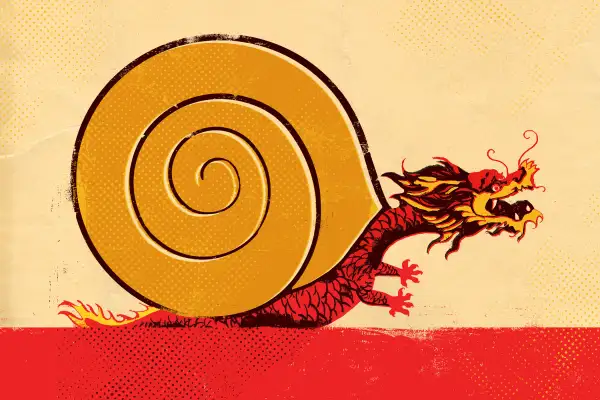China's Boom Is Over — and Here's What You Can Do About It
Money is not a client of any investment adviser featured on this page. The information provided on this page is for educational purposes only and is not intended as investment advice. Money does not offer advisory services.

Every so often an investment theme comes along that seems so big and compelling that you feel it can’t be ignored. This happened in the 1980s with Japanese stocks. It happened again with the Internet boom of the 1990s. You know how those ended.
Today history appears to be repeating itself in China.
Just a decade ago, China was hailed as the engine that would single-handedly drive the global economy for years to come. That seemed plausible, as a billion Chinese attempted something never before accomplished: transitioning from an agrarian to an industrial to a consumer economy, all in a single generation.
Recently, however, this ride to prosperity has hit the skids. A real estate bubble threatens to crimp consumer wealth; over-investment in a wide range of industries is likely to dampen growth; and the transition to a developed economy is stuck in an awkward phase that has trapped other emerging markets.
No wonder Chinese equities—despite a strong rebound last year—are down around half from their 2007 peak.
Like the Japan and dotcom manias before it, China looks like an old story. “Do you have to be in China?” asks Henrik Strabo, head of international investments for Rainier Investment Management in Seattle. “The truth is, no.”
If you’ve bought the China story—and since 2000 hundreds of thousands of U.S. investors have plowed $176 billion into emerging-markets mutual and exchange-traded funds, which have big stakes in China—that’s a pretty bold statement.
In fact, even if you haven’t invested directly in Chinese stocks and simply hold a broad-based international equity fund, China’s Great Slowdown has an impact on how you should think about your portfolio. Here’s what you need to understand about China’s next chapter.
China Has Hit More Than a Speed Bump
After expanding at an annual clip of more than 10% a decade ago, China’s economy has slowed, growing at just over 7% in 2014. That’s expected to fall to 6.5% in the next couple of years, according to economists at UBS. And then it’s “on to 5% and below over the coming decade,” says Jeffrey Kleintop, chief global investment strategist at Charles Schwab.
Why is this worrisome when gross domestic product in the U.S. is expanding at a much slower 3%?
For starters, it represents a steep drop from prior expectations. As recently as three years ago, economists had been forecasting that China would still be growing at roughly an 8% clip by 2016.
The bigger worry is that the slowdown means that China has reached a phase that frustrates many emerging economies on the path to becoming fully “developed,” a stage some economists refer to as the middle-income trap.
On the one hand, a growing number of Chinese are approaching middle-class status, which means wages are on the rise. That sounds good, but rising labor costs chip away at China’s competitive advantage in older, industrial sectors. “You’re seeing more and more manufacturers look at other, cheaper markets like Indonesia, Vietnam, and the Philippines,” says Eric Moffett, manager of the T. Rowe Price Asia Opportunities Fund.
At the same time, the country’s new consumer-centric economy has yet to fully form. About half of China’s urban population is thought to be middle-class by that nation’s standards, but half of Chinese still live in the countryside, and the vast majority of those households are poor. Couple this with the deteriorating housing market—which accounts for the bulk of the wealth for the middle class—and you can see why China isn’t able to buy its way to prosperity just yet.
This in-between stage is when fast-growing economies typically downshift significantly. After prolonged periods of “supercharged” expansion, these economies tend to suffer through years when they regress to a more typical rate of global growth, according to a recent paper by Harvard professors Lawrence Summers and Lant Pritchett.
In some cases, like Brazil, this slowdown prevents the economy from taking that final step to advanced status. Brazil had been expanding 5.2% a year from 1967 to 1980, but that growth slowed to less than 1% annually from 1981 to 2002.
No one is saying China will be stuck in this trap for a generation, like Brazil, but China could be looking at a long-term growth rate closer to 4% to 5% than 8% to 10%.
Your best strategy: Go where the growth is—at home. A few years ago the global economy was expected to expand at an annual pace of 4.2% in 2015, trouncing the U.S. Today the forecast is down to 3.1%, pretty much the same pace as the U.S. economy, which is expected to keep accelerating through 2017.
In recent years, some market strategists and financial planners have instructed investors to keep as much as 40% to 50% of their stocks in foreign funds. But dropping that allocation to 20% to 30% still gives you most of the diversification benefit of owning non-U.S. stocks.
The Losers Aren’t Just in Asia
China’s rise to power lifted the fortunes of its neighboring trade partners too, so it stands to reason that a broad swath of the emerging markets is now at risk. “China is still the beating heart of Asia and the emerging markets,” says Moffett. “If it slows down, all the other countries exporting to and importing from China will see their growth prospects affected.”
The country’s biggest trading partners in the region are Hong Kong, Japan, South Korea, and Taiwan, and all are slowing down. Economists forecast that the growth rates in those four nations will slip below 3% next year.
Beyond Asia, “you have to be careful with the commodity exporters,” says Rainier’s Strabo. China’s slowdown over the past five years is a big reason commodity prices in general and oil specifically have sunk more than 50% since 2011.
China consumes about 40% of the world’s copper and 11% of its oil. As the country’s appetite for commodities wanes, natural resource producers such as Australia, Russia, and Latin America will feel the blow.
Your best strategy: Keep your emerging-markets stake to around 5% of your total portfolio. If your only foreign exposure is a total international equity fund, then you’re probably already there. If, however, you’ve tacked on an emerging-markets “tilt” to your portfolio to try to boost returns, unwind those positions, starting with funds focusing on Asia, Latin America, or Russia.
Here’s another bet that’s now played out: A popular strategy in the global slowdown was to take fliers on Western companies with the biggest exposure to China—companies such as the British spirits maker Diageo (think Johnnie Walker and Guinness) and Yum Brands (KFC and Pizza Hut)—solely because of their China reach. And for a while, that paid off.
Now, though, the stocks of Yum and Diageo have stalled, and major global companies such as Anheuser-Busch InBev and Unilever have reported disappointing results recently in part owing to subpar sales in China as well as in other emerging markets.
Demographic Problems Will Only Make Things Worse
For years, China’s sheer size was seen as a massive competitive advantage. Indeed, China has three times as many workers as the United States has people.
Yet as the country’s older workers have been retiring, China’s working-age population has been quietly shrinking in recent years. Economists say this will most likely lead to labor shortages over the coming years, putting even more pressure on wages to rise.
China’s demographic problem has been exacerbated by the country’s “one-child” policy, which has prevented an estimated 400 million births since 1979. But China isn’t the only emerging market suffering from bad demographic trends.
Birthrates are low throughout East Asia. The ratio of people 15 to 64 to those 65 and older will plummet from about 7 to 1 to 3 to 1 in the next 15 years in Taiwan, South Korea, and Hong Kong, dragging down growth.
Your best strategy: If you’re a growth-focused investor who wants more than that 5% stake in emerging markets, concentrate on developing economies with more youthful populations and more potential to expand. One fund that gives you that—with big holdings in the Philippines, Saudi Arabia, Egypt, and Colombia—is Harding Loevner Frontier Emerging Markets . Over the past five years, the fund has gained around 7% a year, more than triple the return of the typical emerging-markets portfolio.
Another option is EGShares Beyond BRICs . Rather than investing in the emerging markets’ old-guard leaders—Brazil, Russia, India, and China—this ETF counts firms from more consumer-driven economies, such as Mexico and Malaysia, among its top holdings.
The Parallels Between China and 1990s Japan are Alarming
For starters, China is facing a real estate crisis similar to Japan’s, says Nariman Behravesh, chief economist at IHS. With easy access to cheap credit, developers have flooded the major cities with excess housing. Floor space per urban resident has grown to 40 square meters, compared with just 35 square meters in Japan and 33 in the U.K.
Not surprisingly, prices in 100 top Chinese cities have been sliding for seven months. Whether China’s property bubble bursts or not, falling home values chip away at household net worth; that, in turn, drags down consumer sentiment and spending, Behravesh says.
Other unfortunate similarities between the two nations: Excess capacity plagues numerous sectors of China’s economy, ranging from steel to chemicals to an auto industry made up of 96 car brands.
Also, Chinese officials face political pressure to focus on short-term growth rather than long-term fixes. This type of thinking has resulted in the rise of so-called zombie companies, much like what Japan saw in the ’90s. “These are companies that aren’t really viable but are being kept alive,” Behravesh says. Yet for the economy to get back on track, inefficiently run businesses have to be allowed to fail, market strategists say.
Your best strategy: Focus on the few major differences between the two countries. Unlike Japan, for instance, China is still a young, emerging economy. Slowdown or not, “the growth of the middle class will continue in China, and that will absorb some of the overhang in the economy, which is something Japan couldn’t count on,” says Michael Kass, manager of Baron Emerging Markets Fund.
What’s more, when Japan’s bubble burst in late 1989, stocks in that country were trading at a frothy price/earnings ratio of around 50. By contrast, Chinese shares trade at a reasonable P/E of around 10.
To be sure, not all Chinese stocks enjoy such low valuations. As competition heats up to supply China’s population with basic goods, valuations on consumer staples companies have nearly doubled over the past four years to a P/E of around 27.
At the same time, the loss of faith in the Chinese story means there are decent values in industries that cater to the established middle and upper-middle class, says Nick Niziolek, co-manager of the Calamos Evolving World Growth Fund. Health care and gaming stocks in particular suffered setbacks last year. And Chinese consumer discretionary stocks are trading at a P/E of just 12, down from 20 five years ago.
You can invest in such businesses through EGShares Emerging Markets Domestic Demand ETF , which owns shares of companies that cater to local buyers within their home countries, rather than relying on exports. Chinese shares represent about 17% of the fund, led by names such as China Mobile.
That one of the world’s great growth stories is now best viewed as a place to pick up stocks on the cheap might seem a strange twist—until you remember your Japanese and Internet history.
